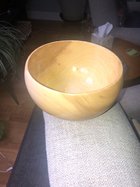I have some of what I believe is serviceberry. It’s pretty light colored, with an interesting but subtle grain pattern. I haven’t been happy with anything I have finished it with. Shellac, tung, linseed, danish oil all seem to bring out the yellow tones and mute the grain pattern. I’d like to highlight the grain and bring in more red or brown to offset the yellowing.
I’m pretty sure water base poly would not bring out the yellow, but I don’t think it will do anything to highlight the grain or chatoyance. Plus, I’d like to stay with natural finishes.
Is there any treatment that will highlight the grain and bring out more of the browns or mute the yellow ? Ammonia fuming doesn’t seem to do anything. I’m wondering about vinegar and steel, or lye, etc.
Any ideas? Im nearly ready to start finishing another piece from this tree. (I’m not ready to start messing around with dyes yet. )
The picture is the last piece I made from this tree, finished with shellac.
TIA
I’m pretty sure water base poly would not bring out the yellow, but I don’t think it will do anything to highlight the grain or chatoyance. Plus, I’d like to stay with natural finishes.
Is there any treatment that will highlight the grain and bring out more of the browns or mute the yellow ? Ammonia fuming doesn’t seem to do anything. I’m wondering about vinegar and steel, or lye, etc.
Any ideas? Im nearly ready to start finishing another piece from this tree. (I’m not ready to start messing around with dyes yet. )
The picture is the last piece I made from this tree, finished with shellac.
TIA

